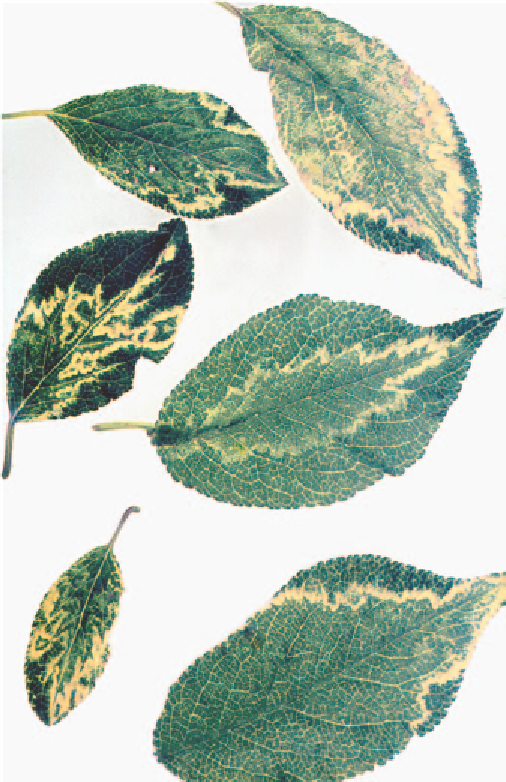Agriculture Reference
In-Depth Information
Use resistant rootstock, such as Nemaguard, in infected
areas. However, be aware that Nemaguard is only
resistant to root-knot nematode, and is not effective
against root-lesion nematode. Root-lesion nematode is
the prevalent species in some Australian regions (e.g. the
Granite Belt). There are no pesticides registered for
nematode control in stone fruit.
Symptoms
The general types of symptoms that can develop are
chlorosis, necrosis, leaf deformity and stunting.
Symptom expression is variable and depends on the
virus or virus strain, cultivar, growth stage and weather
conditions.
Some cultivars are symptomless throughout their life
or develop leaf symptoms for only a short period in
spring. Symptoms on these plants are usually chlorotic
spots, ringspots or mottling on the new growth. In
some cultivars, the chlorotic spots become necrotic
and drop out giving the leaf a shothole or tatter-leaf
appearance.
•
Avoid planting stone fruit into soils previously planted
to nematode-susceptible crops, such as grapes. Grain
crops are not hosts of root-lesion nematodes and can
be planted on fallow blocks to reduce nematode
numbers.
•
In replant situations:
•
Affected trees may also develop a green and white mosaic
pattern on leaves. Some plum cultivars produce yellow to
almost white or pale green lines on leaves, frequently
forming oak-leaf, ringspot and vein-banding patterns.
These symptoms usually appear during the cooler spring
-
if possible, fallow soils for up to four seasons; as a
absolute minimum, do not replant stone fruit for at
least one year after removing old trees
-
during the fallow period, grow green manure cover
crops (e.g. oats during winter, sorghum x sudan grass
hybrids during summer) to increase soil organic
matter
-
prepare soil by ploughing deeply, ripping and discing
to remove old trees roots.
VIRUSES
Virus infection in Australian stone fruit orchards is relatively
common and most likely underestimated, because virus
symptoms are generally transitory and often masked by
factors such as high temperatures and high nutrient levels.
Some of the symptoms of virus infection are also produced
by other pathogens; for example, shot-hole symptoms.
Despite the lack of clear symptoms, virus infection
has a considerable effect on plant vigor, yield and fruit
quality. Virus infection is a common cause of stock/
scion incompatibility, resulting from death of the
graft union.
PRUNUS RINGSPOT
■
Cause
Prunus ringspot virus
es. Several related viruses and virus
strains belonging to the Ilarvirus group of plant viruses
very commonly infect
Prunus
species in all countries where
they are grown. The viruses involved are often termed the
'prunus ringspot group' and induce a range of symptoms
and effects on plants, depending on the virus strain,
cultivar and environmental conditions.
Fig 17.27
Prunus ringspot virus
on plum leaves.












